英语主谓一致精讲精练
(完整word版)主谓一致语法讲解及习题
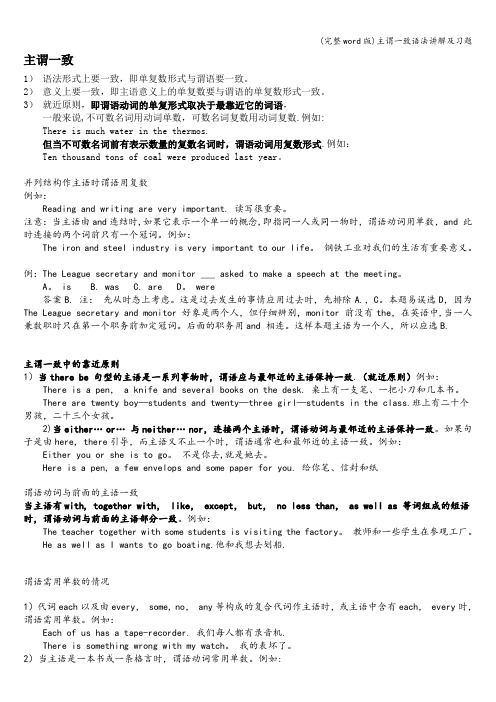
主谓一致1)语法形式上要一致,即单复数形式与谓语要一致。
2)意义上要一致,即主语意义上的单复数要与谓语的单复数形式一致。
3)就近原则,即谓语动词的单复形式取决于最靠近它的词语,一般来说,不可数名词用动词单数,可数名词复数用动词复数.例如:There is much water in the thermos.但当不可数名词前有表示数量的复数名词时,谓语动词用复数形式.例如:Ten thousand tons of coal were produced last year。
并列结构作主语时谓语用复数例如:Reading and writing are very important. 读写很重要。
注意:当主语由and连结时,如果它表示一个单一的概念,即指同一人或同一物时,谓语动词用单数,and 此时连接的两个词前只有一个冠词。
例如:The iron and steel industry is very important to our life。
钢铁工业对我们的生活有重要意义。
例:The League secretary and monitor ___ asked to make a speech at the meeting。
A。
is B. was C. are D。
were答案B. 注:先从时态上考虑。
这是过去发生的事情应用过去时,先排除A.,C。
本题易误选D,因为The League secretary and monitor 好象是两个人,但仔细辨别,monitor 前没有the,在英语中,当一人兼数职时只在第一个职务前加定冠词。
后面的职务用and 相连。
这样本题主语为一个人,所以应选B.主谓一致中的靠近原则1)当there be 句型的主语是一系列事物时,谓语应与最邻近的主语保持一致.(就近原则)例如:There is a pen, a knife and several books on the desk. 桌上有一支笔、一把小刀和几本书。
主谓一致-讲解++练习(全)
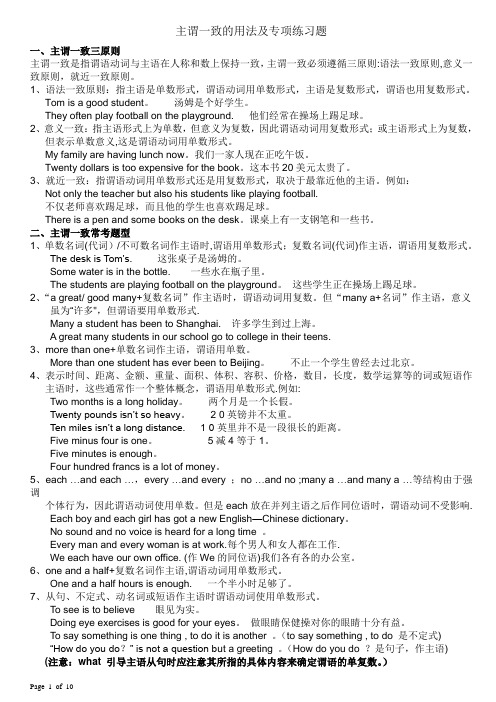
主谓一致的用法及专项练习题一、主谓一致三原则主谓一致是指谓语动词与主语在人称和数上保持一致,主谓一致必须遵循三原则:语法一致原则,意义一致原则,就近一致原则。
1、语法一致原则:指主语是单数形式,谓语动词用单数形式,主语是复数形式,谓语也用复数形式。
Tom is a good student。
汤姆是个好学生。
They often play football on the playground. 他们经常在操场上踢足球。
2、意义一致:指主语形式上为单数,但意义为复数,因此谓语动词用复数形式;或主语形式上为复数,但表示单数意义,这是谓语动词用单数形式。
My family are having lunch now。
我们一家人现在正吃午饭。
Twenty dollars is too expensive for the book。
这本书20美元太贵了。
3、就近一致:指谓语动词用单数形式还是用复数形式,取决于最靠近他的主语。
例如:Not only the teacher but also his students like playing football.不仅老师喜欢踢足球,而且他的学生也喜欢踢足球。
There is a pen and some books on the desk。
课桌上有一支钢笔和一些书。
二、主谓一致常考题型1、单数名词(代词)/不可数名词作主语时,谓语用单数形式;复数名词(代词)作主语,谓语用复数形式。
The desk is Tom’s. 这张桌子是汤姆的。
Some water is in the bottle. 一些水在瓶子里。
The students are playing football on the playground。
这些学生正在操场上踢足球。
2、“a great/ good many+复数名词”作主语时,谓语动词用复数。
但“many a+名词”作主语,意义虽为“许多",但谓语要用单数形式.Many a student has been to Shanghai. 许多学生到过上海。
主谓一致精讲、精练、精析
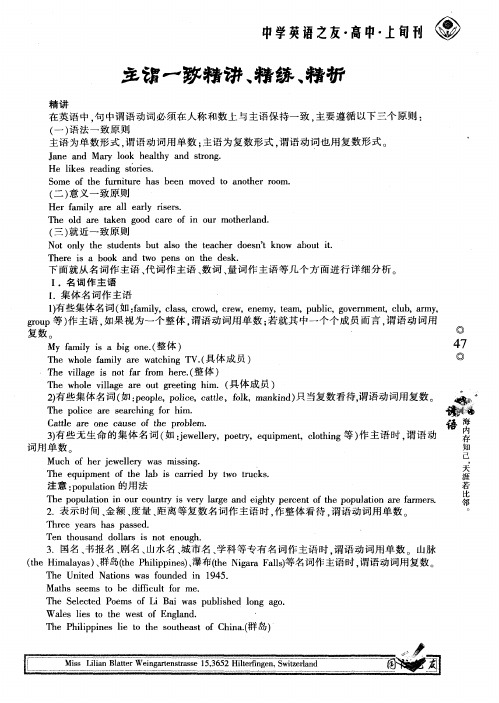
( ) 义一 致原 则 二 意
He a l r l e r ie s r fmi a e al a l rs r . y y
The l a e a n o d a e o n ur od r tke g o c r f i o mo h ra d. teln
中 英 之 .中t T⑨ 学 语 友高 . ̄' J
壹 谤 一 糟 谤 、 练 、 精 糟
精 讲
在 英语 中 . 中谓语 动词 必须 在人 称 和数 上 与主语 保持 一致 , 句 主要遵 循 以下 三个 原 则 : ( ) 法 一致 原则 一 语 主语 为单数 形 式 , 语动 词用 单数 ; 谓 主语 为复 数形 式 , 语 动词 也用 复数 形 式 。 谓
T e Un td Na in s f u d d i 1 4 . h i t s wa n e n 9 5 e o o Mah e ms t e d fiu t f r me t s s e o b i c l o . f
Th S l c e Po ms f Li e e e td e o Ba wa b ih d l n g . i s pu ls e o g a o W ae le t t e l s i s o h we t o g a d. s f En l n
J n n r o k h aty a d srn . a e a d May lo e l n t g h o
He lk s r a n so is i e e di g t re .
S me o h u n t r a e n mo e o a o h r r o o f t e f r i e h s b e v d t n t e o m. u
(精华版)高中英语“主谓一致”精讲精练高考真题大全带答案

(精华版)高中英语“主谓一致”精讲精练大全带答案一.概念:主谓一致是指:1)语法形式上要一致,即单复数形式与谓语要一致。
2)意义上要一致,即主语意义上的单复数要与谓语的单复数形式一致。
3)就近原则,即谓语动词的单复形式取决于最靠近它的词语,一般来说,不可数名词用动词单数,可数名词复数用动词复数。
例如:There is much water in the thermos.但当不可数名词前有表示数量的复数名词时,谓语动词用复数形式。
例如:Ten thousand tons of coal were produced last year.二.相关知识点精讲1.并列结构作主语时谓语用复数,例如:Reading and writing are very important. 读写很重要。
注意:当主语由and连结时,如果它表示一个单一的概念,即指同一人或同一物时,谓语动词用单数,and 此时连接的两个词前只有一个冠词。
例如:The iron and steel industry is very important to our life. 钢铁工业对我们的生活有重要意义。
典型例题The League secretary and monitor ___ asked to make a speech at the meeting.A. isB. wasC. areD. were答案B. 注:先从时态上考虑。
这是过去发生的事情应用过去时,先排除A.,C。
本题易误选D,因为The League secretary and monitor 好象是两个人,但仔细辨别,monitor 前没有the,在英语中,当一人兼数职时只在第一个职务前加定冠词。
后面的职务用and 相连。
这样本题主语为一个人,所以应选B。
2. 主谓一致中的靠近原则1)当there be 句型的主语是一系列事物时,谓语应与最邻近的主语保持一致。
例如:There is a pen, a knife and several books on the desk. 桌上有一支笔、一把小刀和几本书。
英语主谓一致精讲及练习题
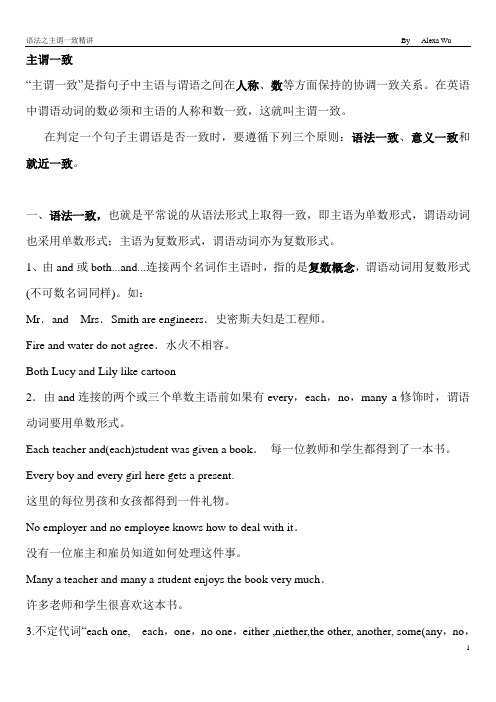
主谓一致“主谓一致”是指句子中主语与谓语之间在人称、数等方面保持的协调一致关系。
在英语中谓语动词的数必须和主语的人称和数一致,这就叫主谓一致。
在判定一个句子主谓语是否一致时,要遵循下列三个原则:语法一致、意义一致和就近一致。
一、语法一致,也就是平常说的从语法形式上取得一致,即主语为单数形式,谓语动词也采用单数形式;主语为复数形式,谓语动词亦为复数形式。
1、由and或both...and...连接两个名词作主语时,指的是复数概念,谓语动词用复数形式(不可数名词同样)。
如:Mr.and Mrs.Smith are engineers.史密斯夫妇是工程师。
Fire and water do not agree.水火不相容。
Both Lucy and Lily like cartoon2.由and连接的两个或三个单数主语前如果有every,each,no,many a修饰时,谓语动词要用单数形式。
Each teacher and(each)student was given a book.每一位教师和学生都得到了一本书。
Every boy and every girl here gets a present.这里的每位男孩和女孩都得到一件礼物。
No employer and no employee knows how to deal with it.没有一位雇主和雇员知道如何处理这件事。
Many a teacher and many a student enjoys the book very much.许多老师和学生很喜欢这本书。
3.不定代词“each one, each,one,no one,either ,niether,the other, another, some(any,no,every)+body(one或thing)”在句中作主语时,或主语由each,each of ,every修饰时,谓语动词一律用单数形式。
初中英语主谓一致精讲及练习(有答案)
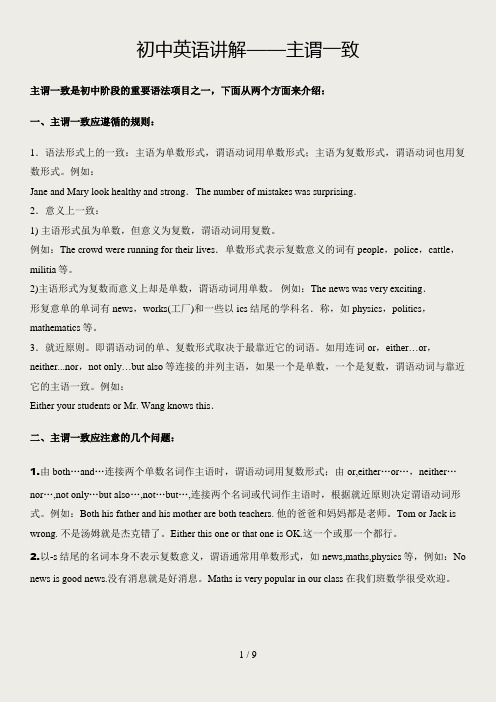
初中英语讲解——主谓一致主谓一致是初中阶段的重要语法项目之一,下面从两个方面来介绍:一、主谓一致应遵循的规则:1.语法形式上的一致:主语为单数形式,谓语动词用单数形式;主语为复数形式,谓语动词也用复数形式。
例如:Jane and Mary look healthy and strong.The number of mistakes was surprising.2.意义上一致:1) 主语形式虽为单数,但意义为复数,谓语动词用复数。
例如:The crowd were running for their lives.单数形式表示复数意义的词有people,police,cattle,militia等。
2)主语形式为复数而意义上却是单数,谓语动词用单数。
例如:The news was very exciting.形复意单的单词有news,works(工厂)和一些以ics结尾的学科名.称,如physics,politics,mathematics等。
3.就近原则。
即谓语动词的单、复数形式取决于最靠近它的词语。
如用连词or,either…or,neither...nor,not only…but also等连接的并列主语,如果一个是单数,一个是复数,谓语动词与靠近它的主语一致。
例如:Either your students or Mr. Wang knows this.二、主谓一致应注意的几个问题:1.由both…and…连接两个单数名词作主语时,谓语动词用复数形式;由or,either…or…,neither…nor…,not only…but also…,not…but…,连接两个名词或代词作主语时,根据就近原则决定谓语动词形式。
例如:Both his father and his mother are both teachers. 他的爸爸和妈妈都是老师。
Tom or Jack is wrong. 不是汤姆就是杰克错了。
最全的高中英语主谓一致讲解及练习-(精华版)

主谓一致(**)主谓一致的概念。
所谓主谓一致是指“主语和谓语动词”之间,即(主语的人称和单复数形式)决定着(谓语动词对应的形式)。
(一)主谓一致的种类一、【语法一致】1. <and连接>两个或两个以上单数名词或者代词作主语的时候,谓语动词有以下两种情况:(1)如果指两个或两个以上不同的人或事物的时候,谓语动词用复数。
He and she_____both studentsofthis school.(2)如果连接两个以上的名词指的是同一个人或物,或者指同一概念的时候, 谓语要用单数。
The singer and dancer____goingto give usa performance.Theknifeand fork ____onthe table.2. 如果主语是不定式,动词ing形式或主语从句的时候,谓语动词一般用单数。
When he is coming seems very important.Collecting stamps is his hobby.To loveher is not tobreakher wings. 爱她就不该折断她自由飞翔的翅膀。
. 3.定语从句的关系代词who, which,that在从句中作主语时,要与<先行词>的人称和数保持一致。
Those who enjoy singing may joinus.Tom, whois your friend, shouldhelp you.如果句子中有这些连接词(with, along with,togetherwith,as wellas,besides,like, without,except, but,including)和主语连用,谓语动词的数随主语的变化而变化。
Theteacher, togetherwithhisstudents, is planting treesin thestreet.二、[意义一致原则]指主谓一致取决于主语的其实际意义。
高中英语主谓一致讲解及练习
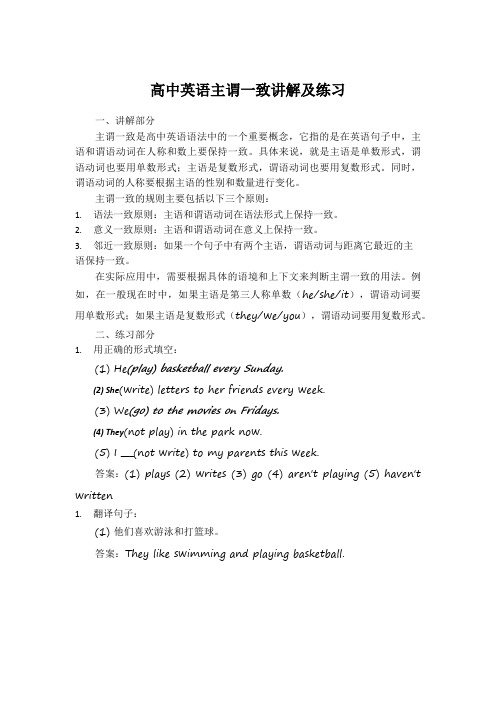
高中英语主谓一致讲解及练习一、讲解部分主谓一致是高中英语语法中的一个重要概念,它指的是在英语句子中,主语和谓语动词在人称和数上要保持一致。
具体来说,就是主语是单数形式,谓语动词也要用单数形式;主语是复数形式,谓语动词也要用复数形式。
同时,谓语动词的人称要根据主语的性别和数量进行变化。
主谓一致的规则主要包括以下三个原则:1.语法一致原则:主语和谓语动词在语法形式上保持一致。
2.意义一致原则:主语和谓语动词在意义上保持一致。
3.邻近一致原则:如果一个句子中有两个主语,谓语动词与距离它最近的主语保持一致。
在实际应用中,需要根据具体的语境和上下文来判断主谓一致的用法。
例如,在一般现在时中,如果主语是第三人称单数(he/she/it),谓语动词要用单数形式;如果主语是复数形式(they/we/you),谓语动词要用复数形式。
二、练习部分1.用正确的形式填空:(1) He(play) basketball every Sunday.(2) She(write) letters to her friends every week.(3) We(go) to the movies on Fridays.(4) They(not play) in the park now.(5) I ___(not write) to my parents this week.答案:(1) plays (2) writes (3) go (4) aren't playing (5) haven't written1.翻译句子:(1) 他们喜欢游泳和打篮球。
答案:They like swimming and playing basketball.。
初中英语语法——主谓一致讲解及练习
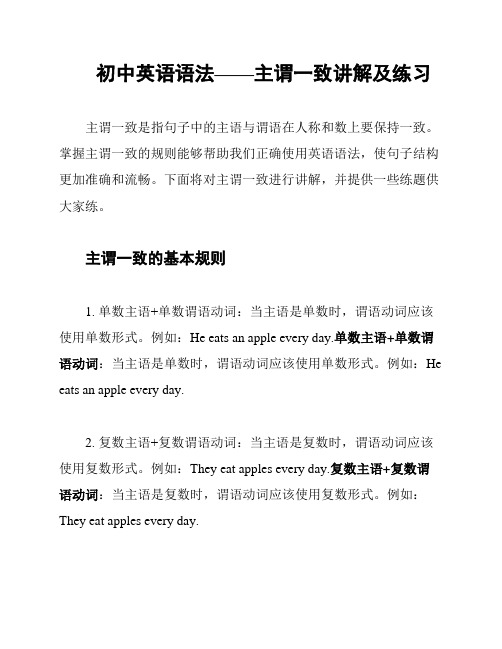
初中英语语法——主谓一致讲解及练习主谓一致是指句子中的主语与谓语在人称和数上要保持一致。
掌握主谓一致的规则能够帮助我们正确使用英语语法,使句子结构更加准确和流畅。
下面将对主谓一致进行讲解,并提供一些练题供大家练。
主谓一致的基本规则1. 单数主语+单数谓语动词:当主语是单数时,谓语动词应该使用单数形式。
例如:He eats an apple every day.单数主语+单数谓语动词:当主语是单数时,谓语动词应该使用单数形式。
例如:He eats an apple every day.2. 复数主语+复数谓语动词:当主语是复数时,谓语动词应该使用复数形式。
例如:They eat apples every day.复数主语+复数谓语动词:当主语是复数时,谓语动词应该使用复数形式。
例如:They eat apples every day.3. 不以-s, -es, -ies结尾的复数主语,还原为单数形式+单数谓语动词:当主语是不以-s, -es, -ies结尾的复数名词时,谓语动词应使用单数形式。
例如:My family is going on a trip this weekend.不以-s, -es, -ies结尾的复数主语,还原为单数形式+单数谓语动词:当主语是不以-s, -es, -ies结尾的复数名词时,谓语动词应使用单数形式。
例如:My family is going on a trip this weekend.4. 以-s, -es, -ies结尾的复数主语,使用复数谓语动词:当主语是以-s, -es, -ies结尾的复数名词时,谓语动词应使用复数形式。
例如:The cats play in the garden.以-s, -es, -ies结尾的复数主语,使用复数谓语动词:当主语是以-s, -es, -ies结尾的复数名词时,谓语动词应使用复数形式。
例如:The cats play in the garden.5. 连接词and连接的两个主语,使用复数谓语动词:当两个主语被连接词and连在一起时,谓语动词应使用复数形式。
【主谓一致精讲】精讲精练
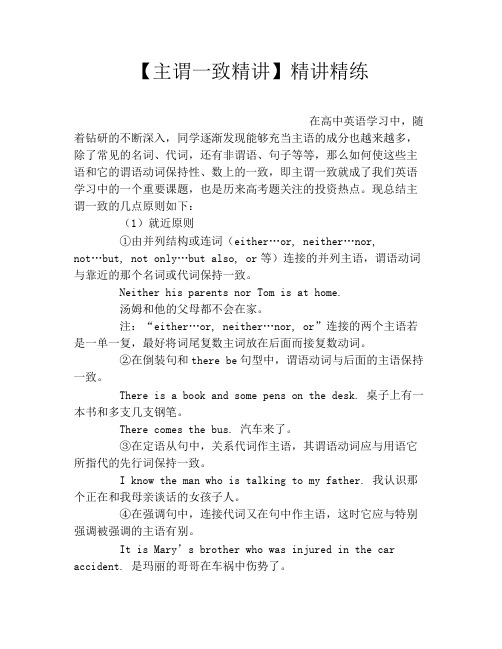
【主谓一致精讲】精讲精练在高中英语学习中,随着钻研的不断深入,同学逐渐发现能够充当主语的成分也越来越多,除了常见的名词、代词,还有非谓语、句子等等,那么如何使这些主语和它的谓语动词保持性、数上的一致,即主谓一致就成了我们英语学习中的一个重要课题,也是历来高考题关注的投资热点。
现总结主谓一致的几点原则如下:(1)就近原则①由并列结构或连词(either…or, neither…nor, not…but, not only…but also, or等)连接的并列主语,谓语动词与靠近的那个名词或代词保持一致。
Neither his parents nor Tom is at home.汤姆和他的父母都不会在家。
注:“either…or, neither…nor, or”连接的两个主语若是一单一复,最好将词尾复数主词放在后面而接复数动词。
②在倒装句和there be句型中,谓语动词与后面的主语保持一致。
There is a book and some pens on the desk. 桌子上有一本书和多支几支钢笔。
There comes the bus. 汽车来了。
③在定语从句中,关系代词作主语,其谓语动词应与用语它所指代的先行词保持一致。
I know the man who is talking to my father. 我认识那个正在和我母亲谈话的女孩子人。
④在强调句中,连接代词又在句中作主语,这时它应与特别强调被强调的主语有别。
It is Mary’s brother who was injured in the car accident. 是玛丽的哥哥在车祸中伤势了。
(2)意义一致原则①当主语与谓语动词之间插入along with, with, as well as, together with, no less than, besides, except, but, including等短语时,谓语动词不受这些插入语的干扰,依然和主语有别。
主谓一致精讲及练习
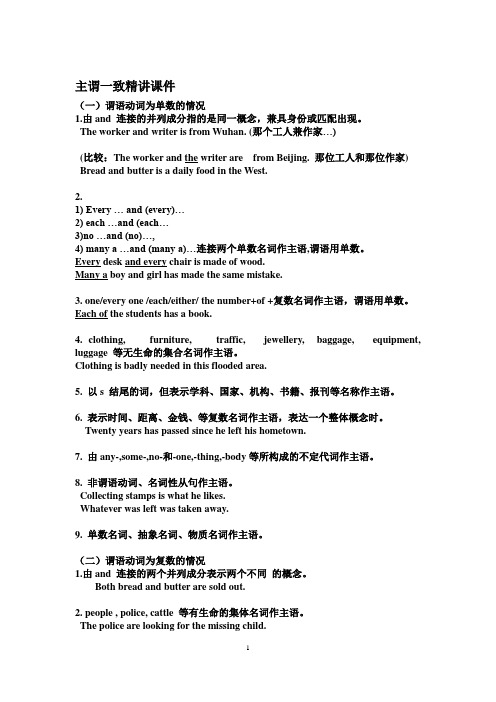
主谓一致精讲课件(一)谓语动词为单数的情况1.由and 连接的并列成分指的是同一概念,兼具身份或匹配出现。
The worker and writer is from Wuhan. (那个工人兼作家…)(比较:The worker and the writer are from Beijing. 那位工人和那位作家) Bread and butter is a daily food in the West.2.1) Every … and (every)…2) each …and (each…3)no …and (no)…,4) many a …and (many a)…连接两个单数名词作主语,谓语用单数。
Every desk and every chair is made of wood.Many a boy and girl has made the same mistake.3. one/every one /each/either/ the number+of +复数名词作主语,谓语用单数。
Each of the students has a book.4. clothing, furniture, traffic, jewellery, baggage, equipment, luggage 等无生命的集合名词作主语。
Clothing is badly needed in this flooded area.5. 以s 结尾的词,但表示学科、国家、机构、书籍、报刊等名称作主语。
6. 表示时间、距离、金钱、等复数名词作主语,表达一个整体概念时。
Twenty years has passed since he left his hometown.7. 由any-,some-,no-和-one,-thing,-body等所构成的不定代词作主语。
8. 非谓语动词、名词性从句作主语。
Collecting stamps is what he likes.Whatever was left was taken away.9. 单数名词、抽象名词、物质名词作主语。
人教社高中英语必修 4 unit 1语法精讲精练-----主谓一致

语法精练---主谓一致必修 4 unit 1Subject-Verb agreement (主谓一致)【命题趋向】高考考察一些特殊名词在主谓一致情况下的形式,如改错,单选等题目。
【基础知识】一、主谓一致的三个原则所谓一致是指句子成分之间或词语之间在人称数、性等方面的协调关系。
主谓一致是指一个句子的主语和谓语动词保持人称与数的一致关系。
一个句子中主谓一致有三种基本原则:语法一致;意义一致;就近一致。
1)语法一致:指句中的动词要和它的主语在语法形式上保持一致。
其最基本的规则是:单数主语需要用单数动词复数主语需要用复数动词。
如:No further explanation has been given by them so far 。
到目前为止,他们还没有作出进一步的解释。
2)意义一致:从意义上看眼处理主谓一致关系,谓语动词的单、复数形式取决于主语所表达的概念,而不取决于表面的语法标志。
如:主语的语法形式为单数,但表示单数意义,谓语动词往往用单数。
如:Bread and butter is what little John enjoys. 小约翰喜欢吃涂有黄油的面包。
(主语加虽有and ,但应作为一个整体看待,即“涂了黄油的面包”。
)3)就近一致:即谓语动词的人称和数往往与最近的主语保持一致。
如:-Not only the students but also teachers should make full use of their time to improvethemselves.不仅学生而且老师也要充分利用时间提高自己。
二、主谓一致用法应用时注意的问题:1)当主语为表示“距离”,“时间”,“长度”,“价值”,“金额”,“重量”,“容量”等复数名词时,可以将其看作一个整体,谓语动词用单数。
Six months is too short a time to learn a language .六个月时间太短,不能学会一门语言。
高中英语主谓一致讲解及练习
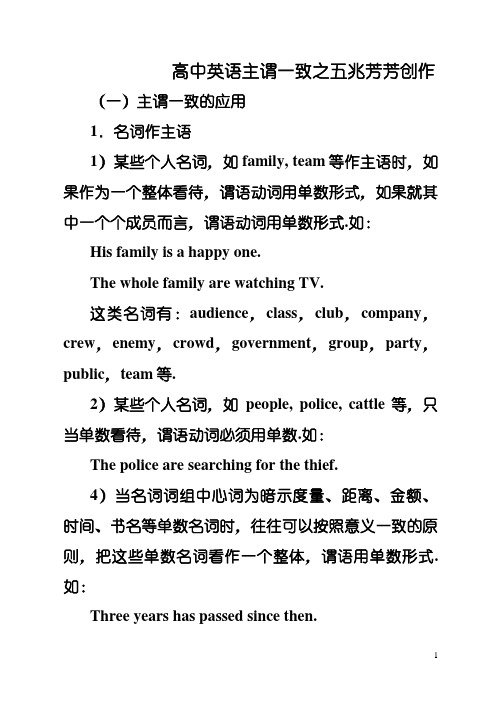
高中英语主谓一致之五兆芳芳创作(一)主谓一致的应用1.名词作主语1)某些个人名词,如family, team等作主语时,如果作为一个整体看待,谓语动词用单数形式,如果就其中一个个成员而言,谓语动词用单数形式.如:His family is a happy one.The whole family are watching TV.这类名词有:audience,class,club,company,crew,enemy,crowd,government,group,party,public,team等.2)某些个人名词,如people, police, cattle等,只当单数看待,谓语动词必须用单数.如:The police are searching for the thief.4)当名词词组中心词为暗示度量、距离、金额、时间、书名等单数名词时,往往可以按照意义一致的原则,把这些单数名词看作一个整体,谓语用单数形式.如:Three years has passed since then.5)不定代词each, every, no所修饰的名词即便以and或逗号连接成多主语时,谓语动词仍用单数形式.如:Each boy and each girl wants to go to the cinema.6)如果主语有more than one良多很是…或many a许多……组成,尽管从意义上看是单数内容,但它的谓语动词仍用单数形式.如:More than one student has read the book.Many a girl has been there.7)一些有两个部分组成的名词暗示衣物或东西作主语时,谓语动词通经常使用单数形式,例如:glasses, clothes, trousers, shoes, compasses, chopsticks, scissors 等.但如果主语用“a kind of, a pair of , a series of等加名词”组成时,谓语动词一般用单数形式.如:A pair of shoes was on the desk.8)this kind of men的谓语动词用单数,men of this kind的谓语动词用单数,all kinds of后跟单数名词,谓语动词用单数形式.如:This kind of men is dangerous.Men of this kind are dangerous.9)单数形式的单、单数同形名词作主语时,按意义一致原则,作用单数意义时,谓语用单数,反之,谓语用单数.这类名词有:means(办法),works(工场),species(种类),Chinese,Japanese等.如:The (This) glass works was set up in 1980. (这家玻璃厂建于1980年.)The(These)glass works are near the railway station. (这些玻璃厂在火车站邻近.)10)all,most, half, rest of看of前面的词,所指的单数意义,谓语动词用单数形式;反之,用单数.如:All of my classmates like music.All of the water is gone.11)在主谓倒装的句子中,谓语动词的数应与其后的主语一致.如:Between the two windows hangs a picture.2.由连接词连接的名词作主语1)用and或both…and连接并列主语,谓语动词通经常使用单数形式.如:Plastics and rubber never rot.Walking and riding are good exercises.2)当主语前面跟有as well as, as much as, no less than, along with, with, like, rather than, together with, but, except, besides, including, in addition to等引导的词组时,其谓语动词的单、单数由引导词前面的主语而定.如:The teacher as well as the students was reading in the library.3)以or, either…or, neither…nor, not only…but also等连接的名词(代词)作主语时,谓语动词的单单数应按照就近一致的原则.如:Tom or his brothers are waiting in the room.Either you or he is to go.3.代词作主语1)关系代词who, that, which等在定语从句中作主语时,其谓语动词的数应与句中先行词的数一致.如:Those who want to go please put up your hands.Some of the energy that is used by man comes fromthe sun.2)疑问代词who, what, which作主语时,谓语动词可按照说话人所要表达的意思决定单、单数.如:Who lives next door ? It is Xiao Liu.Who live next door ? It is Zhang and Liu.What produce(s) heat ?4.分数、量词作主语1)“分数或百分数+名词”组成的短语以及由“a lot of, lots of plenty of, a large quantity of, half of +名词”组成的短语作主语时,其谓语动词要与短语中of前面的名词的数保持一致,这是因为短语中前面的名词是中心词,而短语中前面的量词是修饰语,例如:Lots of damage was caused by fire.About three-fourths of the earth’s surface is covered with water. Three-fifths of the workers here are women.和这种情况类似的还有“a number of+名词单数”谓语用单数译为大量,许多,the number of中心词是number,谓语用单数,译为…的数量A number of students have gone home.The number of pages in this book is two hundred. 注意:(large)quantities of……不成数名词,其短语作主语时,谓语动词一般用单数,例如:Quantities of food(nuts) were on the table.短语in quantity, in large quantities意为“大量”;in small quantities意为“少量”.2)a great deal of , a large amount of修饰不成数名词,其短语作主语时,谓语动词通经常使用单数;large amounts of修饰不成数名词,其短语作主语时,谓语动词通经常使用单数,例如:A large amount of(A great deal of)damage was done in a very short time.Large amounts of money were spent on the bridge.3)暗示数量的one and a half后,名词要用单数形式,但是其短语作主语时,谓语动词用单数形式,例如:One and a half bananas is left on the table.5.名词化的形容词作主语如果主语由“the+形容词(或过来分词)”结构担任时,谓语通经常使用单数,这类词有:the brave, the poor, the rich, the blind, the young, the old, the sick, the dead, the deaf and dumb, the oppressed, the injured, the wounded, the unemployed等;The blind study in special schools.The poor live in aundeveleped country6.从句作主语1)由what引导的主语从句,谓语动词所指的具体内容是单数意义时,谓语动词一般用单数形式,反之,单数.例如:What we need is more time.What we need are doctors.ree ______ died in the terrible fire in Luoyang last winter.A. hundreds peopleB. hundred peopleC. hundreds peoplesD. hundred peoples2. Either you or the president _______ the prizes tothese gifted winners at the meeting.A. is handing outB. are to hand outC. are handing outD. is to hand out3. I, who ______ your close friend, will try my best tohelp you out of trouble.A. amB. isC. areD. be4. The Olympic Games in the year 2008 ______ inBeijing of China, which ______ known to us all.A. is to hold; isB. is to be held; wasC. are to hold; isD. are to be held; is5. There _____ a lot of rubbish on the floor so I askedMary to sweep _____ up.A. were; itB. are; themC. was; itD. is; them6. Three million tons of coal ______ every year in thecity.A. is exploitedB. are exploitedC. had exploitedD. have exploited7. Stories of the Long March _______ popular with theyoung people now.A. isB. wasC. areD. were8. Mathematics _______ the language of science.A. areB. are going to beC. isD. is to be9. Both rice and wheat _____ grown in our country.A. isB. areC. wasD. were10. ________ either of your parents come to see yourecently?A. HaveB.HadC. HasD. Is11. What the children in the mountain village need________ good books.A. isB. areC. haveD. has12. The whole family _______ TV attentively.A. are watchingB. is watchingC. is seeingD. are seeing13. Nothing but several glasses ________ bought by myfather the day before yesterday.A. wasB. wereC. have beenD. would be14. At the bus stop ______ a soldier and two youngpeople on their way to the village.A. wereB. wasC. isD. sits15. If law and order ______, neither the citizen nor hisfamily is safe.A. are not preservedB. is not preservedC. were preservedD. have not been preserved16. There ______ little change in that middle school.A. haveB. hadC. have beenD. has been17. What such a sunset is ______ strange to us all.A. going to beB. /C. isD. that18. Seventy-five percent of the earth’s surface ______with water.A. is coveredB. is coveringC. were coveredD. are covered19. The following ______ some other mental diseases.A. beingB. areC. wasD. were20. Not only you but also I ______ able to help him out.A. areB. isC. amD. were21. “ The Kites” ______ us a story of the kite’s history.A. have toldB. tellsC. were toldD. was told22. You and I _____ twin sisters.A. wereB. areC. isD. am23. A teacher of English and class teacher _______ ussomething about volunteer workers.A. are tellingB. is tellingC. are givenD. weregiven24. Thousands of tons of rubbish ________ over a largeperiod of time.A. rots awayB. rot awayC. has rotted awayD. are rotted away25. Mayor as well as volunteer workers _______ thenewly-built stadium.A. is cleaningB. are cleaningC. were cleaningD. have cleaned26. Many a student ______ something about AbrahamLincoln.A. have knownB. knowsC. is knownD. are known27. The defence works ______ built long ago to keep theenemy away.A. wereB. has beenC. had beenD. was28. “ Have you all studied the passage‘Using the Mindagainst Disease’?”“______ .”A. Nobody of us hasB. Nobody of us haveC. None of us hasD. None of us did29. A group of Italian soldiers ______ quickly towardstheir position.A. were advancingB. were advancedC. was advancingD. advancing30. Everyone, men and women, old and young ______sports and games.A. is enjoyB. were enjoyingC. enjoysD. enjoy1.解析:选B. hundred一词前面有具体数词修饰时不加-s2. 解析:选D. 当either …or 连接两个并列主语时,句子的谓语动词在人称和数上和后一个主语保持一致.“be+不定式”暗示按筹划或安插将要产生的动作.3. 解析:选A. who 为引导定语从句的关系代词,其先行词是I , 所以谓语动词要用am.4. 解析:选D. 主语the Olympic Games 意为:奥运会,谓语动词要用非第三人称单数形式;后半部分为which引导的非限制情定语从句,其谓语动词要用单数形式.5.解析:选C. there be句型中be动词的单单数取决于其后的主语,a lot of rubbish(不成数名词),因此前面谓语动词要用单数.6. 解析:选A. 主语为coal, 是不成数名词.按照题意,此处要用主动语态.7. 解析:选A. 主语Stories of the Long March 是书名,谓语动词要用第三人称单数形式.8. 解析:选C. 此处mathematics 为学科名词,作主语时谓语动词要用第三人称单数形式.9. 解析:选B. both----and---连接两个并列主语时,句子的谓语动词要用非第三人称单数形式.10.解析:选C. either 是主语部分的中心词,助动词要与either要数上保持一致.11.解析:选 B. what 引导的主语从句作主语时,谓语动词要按照前面的名词的数来决定,此处要用非第三人称单数形式.12.解析:选A. 此处指:家里的各个成员,所以谓语动词要用非第三人称单数形式.13. 解析:选A. 此处nothing句子的主语,谓语动词要用第三人称单数形式.14. 解析:选A. 此句为倒装句,句子的主语是a soldier and two young people.15. 解析:选B. 此处主语law and order 指的是同一个概念,所以谓语动词要用第三人称单数形式.16. 解析:选 D. 此处there be结构中的主语little change是不成数名词.17. 解析:选C. 本句是主语从句,缺谓语,所以要用第三人称单数形式.18. 解析:选A. 本句缺谓语,主语percent前面是不成数名词,所以要用第三人称单数形式.19. 解析:选B. 本句的表语是单数形式,所以谓语动词要用非第三人称单数形.20.解析:选C. 按照就近一致性原则,谓语用am.21. 解析:选B. 本句的主语是书名,从整体考虑,谓语是第三人称单数形.22. 解析:选B. 用and连接两个并列主语时,谓语用非第三人称单数形.23.解析:选B. 本句主语是同一团体,谓语用第三人称单数形式.24.解析:选B. 本句主语是tons, 是单数形式,rot是不及物动词,不成用主动形式.25.解析:选A. 本句主语Mayor是单数形式,谓语用第三人称单数形式.26. 解析:选B.主语many a student 意思是单数,形式是单数.谓语动词要用第三人称单数形.27. 解析:选D. 主语works 是荟萃名词,当成整体考虑,谓语动词要用第三人称单数形. Long ago 暗示过来.28. 解析:选C. 因为问句是完成时态,答句要用完成时态答复,另外主语不成用nobody of us.29.解析:选A. 主语a group of 在本句中暗示具体每团体.30. 解析:选C. 本句主语是不定代词everyone,为单数主语,谓语动词要用第三人称单数形.练习:主谓一致2. The rich ____ not always happy.3. Neither Tom nor Jack and I ____ his students.4. Mary as well as her sisters ____ Chinese in China.A. are studyingB. have studiedC.studies D. study5. Neither my father nor I ____ at home.6. Not only my brother but also I ____ good at painting. Both of us ____ good painters.,A.are;areB.am;amC.ani;areD.is;is7. Every' boy and every girl ____ to attend the evening party.8. Over 80 percent of the population of China ____ peasants.9. The population of China ____ larger than thatof .any other country in the world.10. Every means ____ tried but without any result.A. have beenB.is to beC.are to beD. has been11. Alice, together with two boys,____ for having broken the rule.A. was punishedB. punishedC. were punishedD. being punished12. The League secretary and the monitor____ asked to attend the .meeting this afternoon.A.isB.wasC.areD.is being13. The great writer and professor____.A. is an old manB. are both old menC. is an old man and a young manD. were two Chinese14. There ____ a pen, two pencils and three books on the desk.15. A large number of students in our class____ girls.A. areB. wasC. isD. be16. The number of deer, mountain lions and wild roses ____ much if people leave things as they are.17. The Arabian Nights ____ well known to the English.A. isB. areC. wasD. were18. Chairman Mao' s works ____ published.19. A chemical works____ built there.A. is to beingB.have beenC. wereto D.has been20. The Olympic Games ____ held every ____ years.A.is;fourB.are;fourC.is;fiveD.are;five21 .The United States of America one of the most developed countries in the world.22.He is the only one of die students who ____ elected.23.Theis is one of the most interesting questions that ____ asked.A.haveB.hasC. have beenD.has been24.Many a man ____ come to help us.25."All____ present and all____ going on well," our monitor said.A.is;isB.are;areC.are;isD.is;are26. The police ____ the murderer everywhere when he suddenly appeared in a theatre.A. is searching forB. were searching forC. are searching forD. were searching27.Your trousers____ dirty.You must have____ washed.A.is;ilB.are;itC.are;themD.is;them28.This pair of trouseis ____ too long for him.29. One and a half bananas ____ left on the table.30. Eight times eight ____ sixty - four.31 .Ten minutes____ an hour when one is waiting for a phone call.32.____of the money____ nm out.A. Three-fifth; hasB. Three-fifth; has beenC. Three-fifths; hasD. Three-fifths; have33. The whole class ____ the teacher attentively.A. are listening toB. is listening toC.are listeningD. is listening34.1 have finished a large part of the book, the rest of which___ more difficult.35. Between the two rows of trees ____ the teaching building.36. Large quantities of water ____ for irrigation.A. is neededB. has -neededC. are neededD. need37. That they were wrong in these matters ____ now clear to us all.38.What we need____ good textbooks.39. What you said just now____ the matter we are discussing.A.have something to atB. has something to do withC.had something to do withD.has been something to do with40. More than one member ____ against the plan.41. When and where to build the new factory ____ yet.A. has not decidedB. is not decidedC. are not decidedD. have not decided42. Half of the fruit ____ bad.A. areB. hasC. isD. have43. ____ either of your parents come to see you recently?A. HaveB. HadC. HasD. Is44. Mathematics ____ the language of science.A. areB. are going to beC. isD. is to be45. My family ____ small.A. isB. wereC. areD. makes46. The following ____ some other examples.A. areB. isC. wasD. were47. They both have some friends; but his ____ more active.A. isB. will beC. wasD. are48. Both rice and wheat ____ grown in that country.A. isB. areC. wasD. has49. Early to bed and early to rise ____ a good habit.A. areB. isC. wereD. was50. To play basketball and to go swimming ____ useful for character-training.A. wasB. isC. areD. were51. Either he or I ____ to attend the mass meeting this evening.A. isB. amC. areD. be52. ____ either he or I to attend the mass meeting this evening.A. isB. amC. areD. be53. An iron and steel works, with some satellite factories, ____ to be built here.A. areB. wereC. isD. will54. She as well as her brother ____ a League member.A. areB. wereC. willD. is55. His family ____ a big one. Now the family ____ watching TV.A. is, areB. are, isC. is, isD. are, are56. It is I who ____ going to attend the meeting tomorrow.A. isB. amC. areD. be57. More than 60% of the students ____ the countryside.A. isB. areC. is fromD. are from58. Many a man ____ the novel.A. has readB. have readC. is readD. are read59. Tom is the only one of the students who ____ going to swim this afternoon.A. isB. wasC. areD. were60. Here ____ a pen, a few pencils and some paper for you.A. areB. isC. wasD. were答案:1~5 AAACA 6~10 CBDAD 11~15ACABA 16~20 AABDB 21~25 ADCBC26~30 BCAAA 31~35 ACAAB 36~40CABBA 41~45 BCCCA 46~50 ADBBC51~55 BACDA 56~60 BDAAB。
高中英语主谓一致讲解及练习
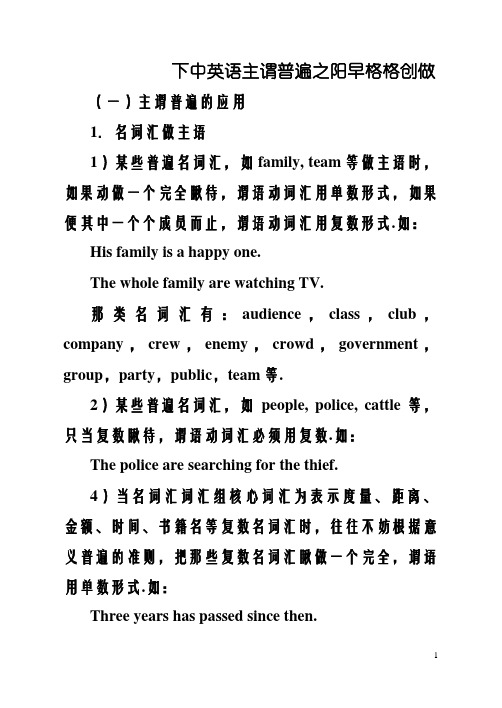
下中英语主谓普遍之阳早格格创做(一)主谓普遍的应用1.名词汇做主语1)某些普遍名词汇,如family, team等做主语时,如果动做一个完全瞅待,谓语动词汇用单数形式,如果便其中一个个成员而止,谓语动词汇用复数形式.如:His family is a happy one.The whole family are watching TV.那类名词汇有:audience,class,club,company,crew,enemy,crowd,government,group,party,public,team等.2)某些普遍名词汇,如people, police, cattle等,只当复数瞅待,谓语动词汇必须用复数.如:The police are searching for the thief.4)当名词汇词汇组核心词汇为表示度量、距离、金额、时间、书籍名等复数名词汇时,往往不妨根据意义普遍的准则,把那些复数名词汇瞅做一个完全,谓语用单数形式.如:Three years has passed since then.5)没有定代词汇each, every, no所建饰的名词汇纵然以and或者逗号连交成多主语时,谓语动词汇仍用单数形式.如:Each boy and each girl wants to go to the cinema.6)如果主语有more than one很多非常…或者many a许多……形成,纵然从意义上瞅是复数实质,然而它的谓语动词汇仍用单数形式.如:More than one student has read the book.Many a girl has been there.7)一些有二个部分形成的名词汇表示衣物或者工具做主语时,谓语动词汇通时常使用复数形式,比圆:glasses, clothes, trousers, shoes, compasses, chopsticks, scissors等.然而如果主语用“a kind of, a pair of , a series of等加名词汇”形成时,谓语动词汇普遍用单数形式.如:A pair of shoes was on the desk.8)this kind of men的谓语动词汇用单数,men of this kind的谓语动词汇用复数,all kinds of后跟复数名词汇,谓语动词汇用复数形式.如:This kind of men is dangerous.Men of this kind are dangerous.9)复数形式的单、复数共形名词汇做主语时,按意义普遍准则,效率单数意义时,谓语用单数,反之,谓语用复数.那类名词汇有:means(要领),works (工厂),species(种类),Chinese,Japanese等.如:The (This) glass works was set up in 1980. (那家玻璃厂建于1980年.)The(These)glass works are near the railway station. (那些玻璃厂正在火车站附近.)10)all,most, half, rest of瞅of后里的词汇,所指的复数意义,谓语动词汇用复数形式;反之,用单数.如:All of my classmates like music.All of the water is gone.11)正在主谓倒拆的句子中,谓语动词汇的数应与其后的主语普遍.如:Between the two windows hangs a picture.2.由连交词汇连交的名词汇做主语1)用and或者both…and连交并列主语,谓语动词汇通时常使用复数形式.如:Plastics and rubber never rot.Walking and riding are good exercises.2)当主语后里跟有as well as, as much as, no less than, along with, with, like, rather than, together with, but, except, besides, including, in addition to等带领的词汇组时,其谓语动词汇的单、复数由带领词汇前里的主语而定.如:The teacher as well as the students was reading in the library.3)以or, either…or, neither…nor, not only…but also等连交的名词汇(代词汇)做主语时,谓语动词汇的单复数应根据便近普遍的准则.如:Tom or his brothers are waiting in the room.Either you or he is to go.3.代词汇做主语1)闭系代词汇who, that, which等正在定语从句中做主语时,其谓语动词汇的数应与句中先止词汇的数普遍.如:Those who want to go please put up your hands.Some of the energy that is used by man comes from the sun.2)疑问代词汇who, what, which做主语时,谓语动词汇可根传闻话人所要表白的意义决断单、复数.如:Who lives next door ? It is Xiao Liu.Who live next door ? It is Zhang and Liu.What produce(s) heat ?4.分数、量词汇做主语1)“分数或者百分数+名词汇”形成的短语以及由“a lot of, lots of plenty of, a large quantity of, half of +名词汇”形成的短语做主语时,其谓语动词汇要与短语中of 后里的名词汇的数脆持普遍,那是果为短语中后里的名词汇是核心词汇,而短语中前里的量词汇是建饰语,比圆:Lots of damage was caused by fire.About three-fourths of the earth’s surface is covered with water. Three-fifths of the workers here are women.战那种情况类似的另有“a number of+名词汇复数”谓语用复数译为洪量,许多,the number of核心词汇是number,谓语用单数,译为…的数量A number of students have gone home.The number of pages in this book is two hundred. 注意:(large)quantities of……没有成数名词汇,其短语做主语时,谓语动词汇普遍用复数,比圆:Quantities of food(nuts) were on the table.短语in quantity, in large quantities意为“洪量”;in small quantities意为“少量”.2)a great deal of , a large amount of建饰没有成数名词汇,其短语做主语时,谓语动词汇通时常使用单数;large amounts of建饰没有成数名词汇,其短语做主语时,谓语动词汇通时常使用复数,比圆:A large amount of(A great deal of)damage was done in a very short time.Large amounts of money were spent on the bridge.3)表示数量的one and a half后,名词汇要用复数形式,然而是其短语做主语时,谓语动词汇用单数形式,比圆:One and a half bananas is left on the table.5.名词汇化的形容词汇做主语如果主语由“the+形容词汇(或者往日分词汇)”结构担当时,谓语通时常使用复数,那类词汇有:the brave, the poor, the rich, the blind, the young, the old, the sick, the dead, the deaf and dumb, the oppressed, the injured, the wounded, the unemployed等;The blind study in special schools.The poor live in aundeveleped country6.从句做主语1)由what带领的主语从句,谓语动词汇所指的简直实质是复数意义时,谓语动词汇普遍用复数形式,反之,单数.比圆:What we need is more time.What we need are doctors.ree ______ died in the terrible fire in Luoyang lastwinter.A. hundreds peopleB. hundred peopleC. hundreds peoplesD. hundred peoples2. Either you or the president _______ the prizes tothese gifted winners at the meeting.A. is handing outB. are to hand outC. are handing outD. is to hand out3. I, who ______ your close friend, will try my best tohelp you out of trouble.A. amB. isC. areD. be4. The Olympic Games in the year 2008 ______ inBeijing of China, which ______ known to us all.A. is to hold; isB. is to be held; wasC. are to hold; isD. are to be held; is5. There _____ a lot of rubbish on the floor so I askedMary to sweep _____ up.A. were; itB. are; themC. was; itD. is; them6. Three million tons of coal ______ every year in thecity.A. is exploitedB. are exploitedC. had exploitedD. have exploited7. Stories of the Long March _______ popular with theyoung people now.A. isB. wasC. areD. were8. Mathematics _______ the language of science.A. areB. are going to beC. isD. is to be9. Both rice and wheat _____ grown in our country.A. isB. areC. wasD. were10. ________ either of your parents come to see yourecently?A. HaveB.HadC. HasD. Is11. What the children in the mountain village need________ good books.A. isB. areC. haveD. has12. The whole family _______ TV attentively.A. are watchingB. is watchingC. is seeingD. are seeing13. Nothing but several glasses ________ bought by myfather the day before yesterday.A. wasB. wereC. have beenD. would be14. At the bus stop ______ a soldier and two young people on their way to the village.A. wereB. wasC. isD. sits15. If law and order ______, neither the citizen nor hisfamily is safe.A. are not preservedB. is not preservedC. were preservedD. have not been preserved16. There ______ little change in that middle school.A. haveB. hadC. have beenD. has been17. What such a sunset is ______ strange to us all.A. going to beB. /C. isD. that18. Seventy-five percent of the earth’s surface ______with water.A. is coveredB. is coveringC. were coveredD. are covered19. The following ______ some other mental diseases.A. beingB. areC. wasD. were20. Not only you but also I ______ able to help him out.A. areB. isC. amD. were21. “ The Kites” ______ us a story of the kite’s history.A. have toldB. tellsC. were toldD. was told22. You and I _____ twin sisters.A. wereB. areC. isD. am23. A teacher of English and class teacher _______ ussomething about volunteer workers.A. are tellingB. is tellingC. are givenD. weregiven24. Thousands of tons of rubbish ________ over a largeperiod of time.A. rots awayB. rot awayC. has rotted awayD. are rotted away25. Mayor as well as volunteer workers _______ thenewly-built stadium.A. is cleaningB. are cleaningC. were cleaningD. have cleaned26. Many a student ______ something about AbrahamLincoln.A. have knownB. knowsC. is knownD. are known27. The defence works ______ built long ago to keep theenemy away.A. wereB. has beenC. had beenD. was28. “ H ave you all studied the passage‘Using the Mindagainst Disease’?”“______ .”A. Nobody of us hasB. Nobody of us haveC. None of us hasD. None of us did29. A group of Italian soldiers ______ quickly towardstheir position.A. were advancingB. were advancedC. was advancingD. advancing30. Everyone, men and women, old and young ______sports and games.A. is enjoyB. were enjoyingC. enjoysD. enjoy1.剖析:选B. hundred一词汇前里有简直数词汇建饰时没有加-s2. 剖析:选D. 当either …or 连交二个并列主语时,句子的谓语动词汇正在人称战数上战后一个主语脆持普遍.“be+没有定式”表示按计划或者安插将要爆收的动做.3. 剖析:选A. who 为带领定语从句的闭系代词汇,其先止词汇是I , 所以谓语动词汇要用am.4. 剖析:选D. 主语the Olympic Games 意为:奥运会,谓语动词汇要用非第三人称单数形式;后半部分为which带领的非节造情定语从句,其谓语动词汇要用单数形式.5.剖析:选C. there be句型中be动词汇的单复数与决于其后的主语,a lot of rubbish(没有成数名词汇),果今后里谓语动词汇要用单数.6. 剖析:选A. 主语为coal, 是没有成数名词汇.根据题意,此处要用主动语态.7. 剖析:选A. 主语Stories of the Long March 是书籍名,谓语动词汇要用第三人称单数形式.8. 剖析:选C. 此处mathematics 为教科名词汇,做主语时谓语动词汇要用第三人称单数形式.9. 剖析:选B. both----and---连交二个并列主语时,句子的谓语动词汇要用非第三人称单数形式.10.剖析:选C. either 是主语部分的核心词汇,帮动词汇要与either要数上脆持普遍.11.剖析:选B. what 带领的主语从句做主语时,谓语动词汇要根据后里的名词汇的数去决断,此处要用非第三人称单数形式.12.剖析:选A. 此处指:家里的各个成员,所以谓语动词汇要用非第三人称单数形式.13. 剖析:选A. 此处nothing句子的主语,谓语动词汇要用第三人称单数形式.14. 剖析:选A. 此句为倒拆句,句子的主语是a soldier and two young people.15. 剖析:选B. 此处主语law and order 指的是共一个观念,所以谓语动词汇要用第三人称单数形式.16. 剖析:选 D. 此处there be结构中的主语little change是没有成数名词汇.17. 剖析:选C. 本句是主语从句,缺谓语,所以要用第三人称单数形式.18. 剖析:选A. 本句缺谓语,主语percent后里是没有成数名词汇,所以要用第三人称单数形式.19. 剖析:选B. 本句的表语是复数形式,所以谓语动词汇要用非第三人称单数形.20.剖析:选C. 根据便近普遍性准则,谓语用am.21. 剖析:选B. 本句的主语是书籍名,从完全思量,谓语是第三人称单数形.22. 剖析:选B. 用and连交二个并列主语时,谓语用非第三人称单数形.23.剖析:选B. 本句主语是共一部分,谓语用第三人称单数形式.24.剖析:选B. 本句主语是tons, 是复数形式,rot是没有及物动词汇,没有成用主动形式.25.剖析:选A. 本句主语Mayor是单数形式,谓语用第三人称单数形式.26. 剖析:选B.主语many a student 意义是复数,形式是单数.谓语动词汇要用第三人称单数形.27. 剖析:选D. 主语works 是集中名词汇,当成完全思量,谓语动词汇要用第三人称单数形. Long ago 表示往日.28. 剖析:选C. 果为问句是完毕时态,问句要用完毕时态回问,其余主语没有成用nobody of us.29.剖析:选A. 主语a group of 正在本句中表示简直每部分.30. 剖析:选C. 本句主语是没有定代词汇everyone,为单数主语,谓语动词汇要用第三人称单数形.训练:主谓普遍2. The rich ____ not always happy.3. Neither Tom nor Jack and I ____ his students.4. Mary as well as her sisters ____ Chinese in China.A. are studyingB. have studiedC.studies D. study5. Neither my father nor I ____ at home.6. Not only my brother but also I ____ good at painting. Both of us ____ good painters.,A.are;areB.am;amC.ani;areD.is;is7. Every' boy and every girl ____ to attend the evening party.8. Over 80 percent of the population of China ____ peasants.9. The population of China ____ larger than that of .any other country in the world.10. Every means ____ tried but without any result.A. have beenB.is to beC.are to beD. has been11. Alice, together with two boys,____ for having broken the rule.A. was punishedB. punishedC. were punishedD. being punished12. The League secretary and the monitor____ asked to attend the .meeting this afternoon.A.isB.wasC.areD.is being13. The great writer and professor____.A. is an old manB. are both old menC. is an old man and a young manD. were two Chinese14. There ____ a pen, two pencils and three books on the desk.15. A large number of students in our class____ girls.A. areB. wasC. isD. be16. The number of deer, mountain lions and wild roses ____ much if people leave things as they are.17. The Arabian Nights ____ well known to the English.A. isB. areC. wasD. were18. Chairman Mao' s works ____ published.19. A chemical works____ built there.A. is to beingB.have beenC. wereto D.has been20. The Olympic Games ____ held every ____ years.A.is;fourB.are;fourC.is;fiveD.are;five21 .The United States of America one of the most developed countries in the world.22.He is the only one of die students who ____ elected.23.Theis is one of the most interesting questions that ____ asked.A.haveB.hasC. have beenD.has been24.Many a man ____ come to help us.25."All____ present and all____ going on well," our monitor said.A.is;isB.are;areC.are;isD.is;are26. The police ____ the murderer everywhere when he suddenly appeared in a theatre.A. is searching forB. were searching forC. are searching forD. were searching27.Your trousers____ dirty.You must have____ washed.A.is;ilB.are;itC.are;themD.is;them28.This pair of trouseis ____ too long for him.29. One and a half bananas ____ left on the table.30. Eight times eight ____ sixty - four.31 .Ten minutes____ an hour when one is waiting for a phone call.32.____of the money____ nm out.A. Three-fifth; hasB. Three-fifth; has beenC. Three-fifths; hasD. Three-fifths; have33. The whole class ____ the teacher attentively.A. are listening toB. is listening toC.are listeningD. is listening34.1 have finished a large part of the book, the rest of which___ more difficult.35. Between the two rows of trees ____ the teaching building.36. Large quantities of water ____ for irrigation.A. is neededB. has -neededC. are neededD. need37. That they were wrong in these matters ____ now clear to us all.38.What we need____ good textbooks.39. What you said just now____ the matter we are discussing.A.have something to atB. has something to do withC.had something to do withD.has been something to do with40. More than one member ____ against the plan.41. When and where to build the new factory ____ yet.A. has not decidedB. is not decidedC. are not decidedD. have not decided42. Half of the fruit ____ bad.A. areB. hasC. isD. have43. ____ either of your parents come to see you recently?A. HaveB. HadC. HasD. Is44. Mathematics ____ the language of science.A. areB. are going to beC. isD. is to be45. My family ____ small.A. isB. wereC. areD. makes46. The following ____ some other examples.A. areB. isC. wasD. were47. They both have some friends; but his ____ more active.A. isB. will beC. wasD. are48. Both rice and wheat ____ grown in that country.A. isB. areC. wasD. has49. Early to bed and early to rise ____ a good habit.A. areB. isC. wereD. was50. To play basketball and to go swimming ____ useful for character-training.A. wasB. isC. areD. were51. Either he or I ____ to attend the mass meeting this evening.A. isB. amC. areD. be52. ____ either he or I to attend the mass meeting this evening.A. isB. amC. areD. be53. An iron and steel works, with some satellite factories, ____ to be built here.A. areB. wereC. isD. will54. She as well as her brother ____ a League member.A. areB. wereC. willD. is55. His family ____ a big one. Now the family ____ watching TV.A. is, areB. are, isC. is, isD. are, are56. It is I who ____ going to attend the meeting tomorrow.A. isB. amC. areD. be57. More than 60% of the students ____ the countryside.A. isB. areC. is fromD. are from58. Many a man ____ the novel.A. has readB. have readC. is readD. are read59. Tom is the only one of the students who ____ going to swim this afternoon.A. isB. wasC. areD. were60. Here ____ a pen, a few pencils and some paper for you.A. areB. isC. wasD. were问案:1~5 AAACA 6~10 CBDAD 11~15ACABA 16~20 AABDB 21~25 ADCBC26~30 BCAAA 31~35 ACAAB 36~40CABBA 41~45 BCCCA 46~50 ADBBC51~55 BACDA 56~60 BDAAB。
高中英语主谓一致讲解及练习
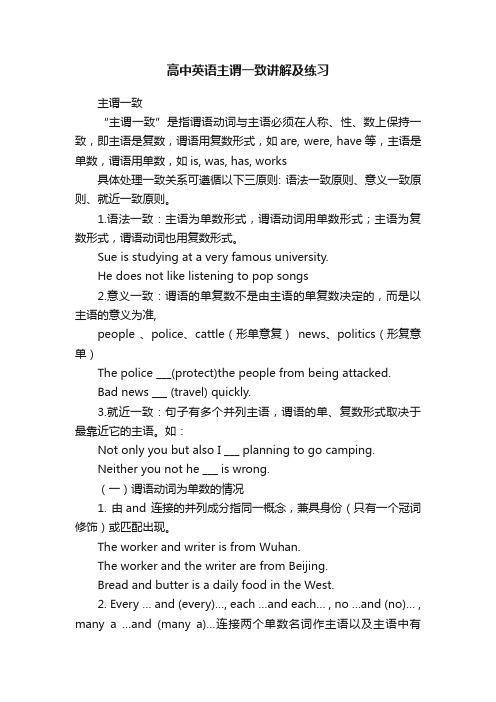
高中英语主谓一致讲解及练习主谓一致“主谓一致”是指谓语动词与主语必须在人称、性、数上保持一致,即主语是复数,谓语用复数形式,如are, were, have等,主语是单数,谓语用单数,如is, was, has, works具体处理一致关系可遵循以下三原则: 语法一致原则、意义一致原则、就近一致原则。
1.语法一致:主语为单数形式,谓语动词用单数形式;主语为复数形式,谓语动词也用复数形式。
Sue is studying at a very famous university.He does not like listening to pop songs2.意义一致:谓语的单复数不是由主语的单复数决定的,而是以主语的意义为准,people 、police、cattle(形单意复)news、politics(形复意单)The police ___(protect)the people from being attacked.Bad news ___ (travel) quickly.3.就近一致:句子有多个并列主语,谓语的单、复数形式取决于最靠近它的主语。
如:Not only you but also I ___ planning to go camping.Neither you not he ___ is wrong.(一)谓语动词为单数的情况1. 由and 连接的并列成分指同一概念,兼具身份(只有一个冠词修饰)或匹配出现。
The worker and writer is from Wuhan.The worker and the writer are from Beijing.Bread and butter is a daily food in the West.2. Every … and (every)…, each …and each… , no …and (no)… , many a …and (many a)…连接两个单数名词作主语以及主语中有many a/an 、more than one、one and a half时。
- 1、下载文档前请自行甄别文档内容的完整性,平台不提供额外的编辑、内容补充、找答案等附加服务。
- 2、"仅部分预览"的文档,不可在线预览部分如存在完整性等问题,可反馈申请退款(可完整预览的文档不适用该条件!)。
- 3、如文档侵犯您的权益,请联系客服反馈,我们会尽快为您处理(人工客服工作时间:9:00-18:30)。
英语主谓一致一)主谓一致的种类1.语法形式上的一致主语为单数形式,谓语动词用单数形式;主语为复数形式,谓语动词也用复数形式。
如:The number of the students present is 200.Jane and Mary look alike.2.意义上一致1)主语形式虽为单数,但意义为复数,谓语动词用复数。
如:The crowd were shouting.单数形式代表复数内容的词有:people, police, cattle等。
2)主语形式为复数,而意义上却是单数,谓语动词用单数。
如:The news was so surprising.形复意单的单词有news和一些以ics结尾的学科名称,如physics,politics, economics等。
3.就近原则即谓语动词的单、复数形式取决于最靠近它的词语。
如用连词or,either…or, neither…not, not only…but also等连接的并列主语,如果一个是单数,一个是复数,谓语动词与靠近它的主语一致。
如:Either your students or Mr. Wang knows this.(二)主谓一致的应用1.名词作主语1)某些集体名词,如family, team等作主语时,如果作为一个整体看待,谓语动词用单数形式,如果就其中一个个成员而言,谓语动词用复数形式。
如:His family is a happy one.The whole family are watching TV.这类名词有:audience,class,club,company,crew,enemy,crowd,government,group,party,public,team等。
名词population一词的使用情况类似。
“a group(crowd) of +复数名词”等短语之后的谓语动词也同样可用单数或复数,前者强调整体,后者强调各个部分。
2)某些集体名词,如people, police, cattle等,只当复数看待,谓语动词必须用复数。
如:The police are searching for the thief.3)单、复数同形的名词主语时,谓语动词应根据意义决定单、复数。
如:A sheep is over there.Some sheep are over there.4)名词所有格之后的名词被省略,这种情况一般只指商店、工厂、住宅等,作主语时,动词一般用单数。
如:The doctor’s is across the street.My uncle’s is not far from here.常见的省略名词有:the baker’s, the barber’s, the carpenter’s, the Zhang’s等。
表示店铺的名词,一般作集体名词看待,但用作主语时,谓语动词往往用复数。
如:Richardson’s have a lot of goods to sell.5)当名词词组中心词为表示度量、距离、金额、时间、书名等复数名词时,往往可以根据意义一致的原则,把这些复数名词看作一个整体,谓语用单数形式。
如:Three years has passed since then.6)不定代词each, every, no所修饰的名词即使以and或逗号连接成多主语时,谓语动词仍用单数形式。
如:Each boy and each girl wants to go to the cinema.7)如果主语有more than on e…或many a…构成,尽管从意义上看是复数内容,但它的谓语动词仍用单数形式。
如:More than one student has read the book.Many a girl has been there.但是,“more +复数名词+than one”结构之后,谓语动词一般多用复数形式。
如:More members than one are against your plan.8)一些有两个部分构成的名词表示衣物或工具作主语时,谓语动词通常用复数形式,例如:glasses, clothes, trousers, shoes, compasses, chopsticks, scissors等。
但如果主语用“a kind of, a pair of , a series of等加名词”构成时,谓语动词一般用单数形式。
如:A pair of shoes was on the desk.9)this kind of book =a book of this kind(这种书),其谓语动词用单数;短语this kind of men =men of this kind =these kind of men(口语)(这一类人),但this kind of men的谓语动词用单数,men of this kind和these kind of men的谓语动词用复数,all kinds of后跟复数名词,谓语动词用复数形式。
如:This kind of men is dangerous.Men of this kind are dangerous.10)复数形式的单、复数同形名词作主语时,按意义一致原则,作用单数意义时,谓语用单数,反之,谓语用复数。
这类名词有:means(方法),works(工厂),species(种类),Chinese,Japanese等。
如:The (This) glass works was set up in 1980. (这家玻璃厂建于1980年。
)The(These)glass works are near the railway station. (这些玻璃厂在火车站附近。
)当它们前面有a, such a , this, that修饰时,谓语用单数;有all, such, these, those修饰时,谓语用复数,但means, no means, the means等词前没有以上修饰词时,可用作单数,也可用作复数。
11)如果名词词组中心词是all,most, half, rest等词语,所指的复数意义,谓语动词用复数形式;反之,用单数。
如:All of my classmates like music.All of the water is gone.12)在主谓倒装的句子中,谓语动词的数应与其后的主语一致。
如:Between the two windows hangs a picture.2.由连接词连接的名词作主语1)用and或b oth…and连接并列主语,谓语动词通常用复数形式。
如:Plastics and rubber never rot.Walking and riding are good exercises.但是,并列主语如果指的是同一个人、同一事物或同一概念时,谓语动词用单数形式,这时and后面的名词没有冠词。
如:Truth and honesty is the best policy.The girl’s teacher and friend is a young doctor.To love and to be loved is great happiness.Going to bed early and getting up early is a good habit.A knife and fork is on the table.2)当主语后面跟有as well as, as much as, no less than, along with, with, like, rather than, together with, but, except, besides, including, in addition to等引导的词组时,其谓语动词的单、复数而定。
如:The teacher as well as the students was reading in the library.3)以or, either…or, neither…nor, not only…but also等连接的名词(代词)作主语时,谓语动词的单复数应根据就近一致的原则。
如:Tom or his brothers are waiting in the room.Either you or he is to go.3.代词作主语1)名词性物主代词作主语时,既可以用作单数,也可以用作复数,这取决于它所代替的是单数还是复数。
如:Ours (Our Party) is a great party.Your shoes are black, and mine(=my shoes) are brown.2)such, the same起指示代词作用时,应根据其所指的内容来决定单、复数。
如:Such is our plan. Such are his words.3)关系代词who, that, which等在定语从句中作主语时,其谓语动词的数应与句中先行词的数一致。
如:Those who want to go please put up your hands.Some of the energy that is used by man comes from the sun.4)疑问代词who, what, which作主语时,谓语动词可根据说话人所要表达的意思决定单、复数。
如:Who lives next door ? It is Xiao Liu.Who live next door ? It is Zhang and Liu.What produce(s) heat ?5)不定代词any, either, neither, none, all some, more等作主语时,有以下两种情况:单独作主语时,视其在文中的意义,动词用单数或复数形式,例如:Now all has been changed. All are present.either, neither单独作主语时,谓语通常用单数。
但后接of时,若of的宾语为不可数名词,动词当然用单数形式,若of的宾语为复数名词或代词时,动词可以是单数,也可以是复数,在正式文体中,单数形式的动词更常用。
如:Do(es) any of you know his address ?None of them has(have)seen the film.4.分数、量词作主语1)“分数或百分数+名词”构成的短语以及由“a lot of, lots of plenty of, a large quantity of, a heap of, heaps of, half of +名词”构成的短语作主语时,其谓语动词要与短语中of后面的名词的数保持一致,这是因为短语中后面的名词是中心词,而短语中前面的量词是修饰语,例如:Lots of damage was caused by fire.About three-fourths of the earth’s surface is covered with water. Three-fifths of the workers here are women.和这种情况类似的还有“a number of+名词复数”,但是,“the number of +名词”的中心词却是number, 试比较:A number of students have gone home.The number of pages in this book is two hundred. 注意:(large)quantities of修饰可数或不可数名词,其短语作主语时,谓语动词一般用复数,例如:Quantities of food(nuts) were on the table.短语in quantity, in large quantities意为“大量”;in small quantities意为“少量”。
